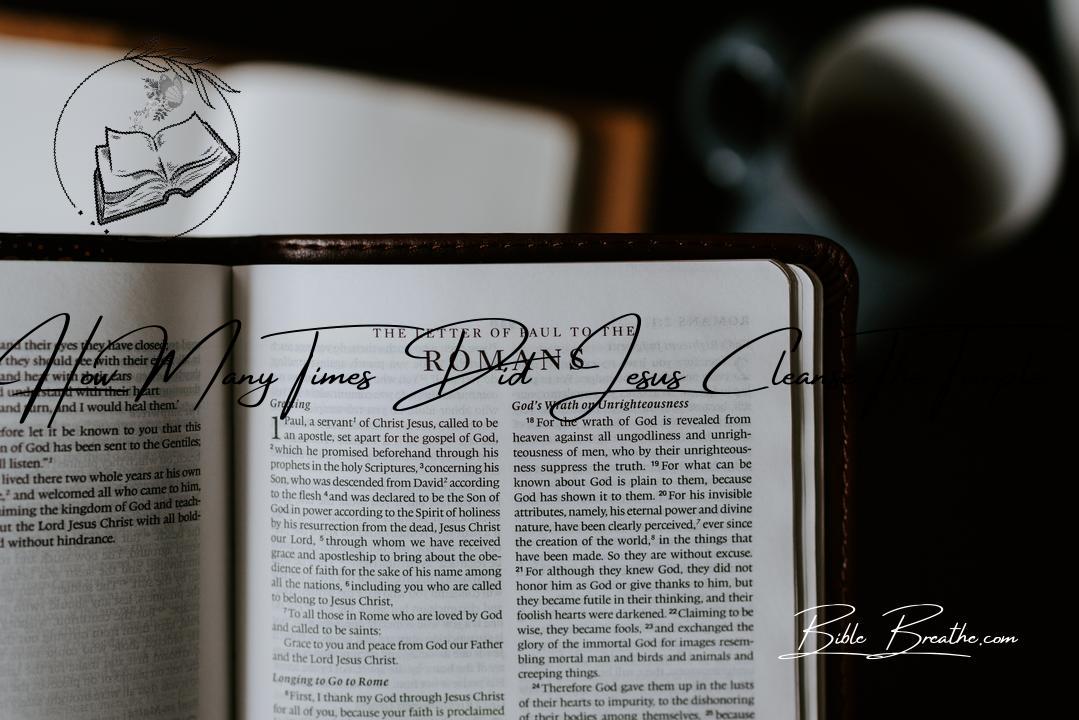How many times did Jesus cleanse the temple, fam?
Let’s dive into this epic Bible moment.
Picture Jerusalem, where the temple was the heart of the action.
It was like the holy HQ, a place for connection and worship.
Now, imagine Jesus rolling into town during Passion Week.
He’s seeing money-changers and folks selling stuff in the temple.
Can you believe it?
He gets righteously mad, calling it a “den of thieves.”
But here’s the kicker – did He do this once or multiple times?
That’s the mystery we’re about to unravel as we journey through the scriptures.
We’ll uncover the significance, tie it to Jewish law, and relate it to those temple sacrifices.
It’s like understanding the secret sauce of Jesus’ mission, y’all.
🏛️✝️
Key Takeaways
- Jesus cleansed the temple on two distinct occasions during His ministry, as recorded in the Gospels. These temple cleansings were pivotal moments that highlighted His zeal for the purity and sanctity of God’s house.
- The temple cleansings challenged religious exploitation and corruption that had infiltrated the temple practices. Jesus confronted the money changers and those who were profiting from the sale of sacrificial animals within the temple courts, emphasizing the need for sincere worship and reverence for God.
- Beyond the commercial interests that had encroached upon the temple, Jesus emphasized the spiritual significance of the temple. He referred to His own body as the ultimate temple, symbolizing the new covenant and the way for humanity to connect with God on a deeper, spiritual level.
- The temple cleansings serve as a powerful illustration of Jesus’ mission to reform religious practices and to call people to genuine faith and worship. They underscore the importance of approaching God with reverence and purity of heart rather than focusing solely on external rituals and transactions.
Cleansing the Temple: Jesus’ Bold Move
Photo modified by BibleBreathe.com. Original photo by Jeswin Thomas on Pexels
Picture this: Jerusalem, a bustling city with streets filled with people and echoing prayers.
At the heart of it all, there’s the Temple, not just bricks and mortar, but a spiritual compass, pointing believers toward the divine.
It’s like your trusty GPS, but for the soul.
Now, here comes Jesus, not with a broom, but with righteous fury.
He walks into the Temple, the sacred hub of Jewish devotion, and what does he do?
He flips tables, sends moneychangers packing, and disrupts the business-as-usual vibe.
“And Jesus went into the temple of God, and cast out all them that sold and bought in the temple, and overthrew the tables of the moneychangers, and the seats of them that sold doves.” – Matthew 21:12 (KJV)
But this wasn’t just a power move; it was a symbol, like cleaning out the clutter in your life.
Imagine a friend inviting you over, and their house is in chaos.
Jesus was saying, “Hey, this place is meant for prayer and connection with God, not for making a quick buck.”
He was shaking things up, challenging the status quo, and calling everyone back to true faith.
It’s like a wake-up call, reminding us that our spiritual journey should never be drowned out by worldly distractions.
“My house shall be called the house of prayer; but ye have made it a den of thieves.” – Matthew 21:13 (KJV)
This bold move wasn’t just about cleaning house; it was about cleansing hearts.
The Temple wasn’t just a fancy building; it was a symbol of faith, a source of hope, and a reminder of the purity of worship.
Jesus wanted everyone to see that, and he did it in a way that’s still talked about today.
Jesus’ Passionate Temple Cleansing: A Lesson in Zeal
Photo modified by BibleBreathe.com. Original photo by EKATERINA BOLOVTSOVA on Pexels
Picture this: The early days of Jesus’ ministry, a bustling Jerusalem filled with excitement after the wedding at Cana, where water turned into wine, showcasing divine abundance.
Passover was approaching, drawing people from all corners to the heart of Jerusalem.
Now, imagine stepping into the sacred Temple in Jerusalem, a place dedicated to solemn worship and communion with God.
Instead of an aura of reverence, what does Jesus encounter?
Money-changers and merchandise sellers have transformed this holy space into a marketplace.
It’s like walking into a church and hearing the bustling sounds of commerce drowning out the prayers – a stark contrast to the sacredness it should hold.
In this moment, righteous anger boils within Jesus, just as it would for anyone witnessing such desecration.
He exclaims, > “My house shall be called the house of prayer; but ye have made it a den of thieves.” – Matthew 21:13 (KJV)
With these words, Jesus not only expresses his disapproval of the Temple’s defilement but also underscores its true purpose.
It’s meant for connecting with the divine, a sanctuary for prayer and spiritual reflection, not a hub for financial transactions.
This event marked the first of two times when Jesus cleansed the Temple.
It shows his unwavering passion for genuine worship and adherence to God’s principles.
Now, let’s reflect on this: Are we safeguarding the sanctity of the sacred in our own lives?
Are we as passionate about genuine worship, not letting distractions dilute its significance?
Jesus’ cleansing of the Temple serves as a timeless reminder to cherish the sacred and prioritize our spiritual journey, even amidst a world clamoring for our attention and devotion.
The Second Temple Cleansing: A Moment of Truth
Photo modified by BibleBreathe.com. Original photo by 𝐕𝐞𝐧𝐮𝐬 𝐇𝐃 𝐌𝐚𝐤𝐞- 𝐮𝐩 & 𝐏𝐞𝐫𝐟𝐮𝐦𝐞 on Pexels
Imagine the scene: The sun paints the sky with shades of gold and crimson as Jesus rolls into Jerusalem, not on a majestic stallion, but a humble donkey.
The crowd goes wild, shouting and laying their cloaks and palm branches before him.
It’s like a royal welcome, but beneath the excitement, tensions simmered.
Right in the heart of the city, you’ve got the Temple, once a place of holiness and prayer, now tainted by money-making schemes.
And right in the midst of this heightened atmosphere, Jesus decides to make a move.
Now, Jesus had already cleaned house in the Temple once before.
That was like a fiery burst of anger at the commercialization of a sacred space.
But the second time around, it’s different.
It’s a deliberate statement, a challenge to the status quo.
“And said unto them, It is written, My house shall be called the house of prayer; but ye have made it a den of thieves.” – Matthew 21:13 (KJV)
The first time, he reacted.
The second time, he acted with intention.
He wanted to remind everyone that the Temple was meant to be holy ground, a place for true devotion.
So, within those sacred walls, Jesus takes on the money-changers and merchandisers.
It’s not just a physical showdown; it’s a clash of ideas, a battle between genuine faith and corruption.
In the face-off with temple officials and chief priests, Jesus stood up for what’s right, calling out their practices and declaring that the Temple should be a place of reverence and spiritual connection.
These moments weren’t just about cleaning up; they were about reclaiming the heart of faith and restoring the sanctity of worship.
Jesus left an unforgettable mark on the Temple and the minds of those who witnessed these powerful events.
It’s like a timeless lesson in staying true to what truly matters.
Shaking Things Up: Jesus’ Passionate Moves in the Temple
Photo modified by BibleBreathe.com. Original photo by Gustavo Fring on Pexels
Jesus wasn’t just casually flipping tables or causing a ruckus in the Temple.
Oh no, these actions were like shockwaves through the religious scene, breaking molds and spotlighting something much deeper.
Jesus’ Heartbeat for God’s House
Picture this: Jesus, passionate about God’s home being a place of genuine worship, was having none of the commercial chaos that had crept in.
The Temple, a symbol of sacredness, shouldn’t double as a marketplace.
He was all about bringing back the true spirit of faith — a heartfelt connection with God, no distractions.
Taking on the Establishment
Jesus didn’t just toss tables; he was challenging a whole system.
It wasn’t just about those money-making maneuvers; it was about questioning the heart of religious practices.
He was daring the norms and calling for a reevaluation of what faith is truly about and what religious leaders should be doing.
The Ancient Predictions Coming True
Now, this is where it gets fascinating.
This uproar in the Temple, Jesus causing a stir, was written in the ancient script long before it happened.
Check out Psalm 69:9 in the KJV: > “The zeal of thine house hath eaten me up.” – Psalm 69:9 (KJV).
Jesus was basically saying, “Hey, the prophets nailed it!”
This wasn’t just some random act; it was a signpost to a major shift on the horizon, foreshadowing Jesus’ life, death, and resurrection.
It was like a righteous reset, purifying beliefs and practices, setting the stage for a new covenant grounded in real faith and spiritual connection.
Jesus wasn’t just stirring the pot in the Temple; he was stirring our hearts, reminding us to keep our beliefs and sacred places pure, even when the world around us might say otherwise.
🙌
Frequently Asked Questions (FAQs) About How Many Times Did Jesus Cleanse The Temple
How many times did Jesus cleanse the temple?
Jesus is recorded cleansing the temple twice in the New Testament, as mentioned in John 2:13-17 and Matthew 21:12-13.
In both instances, He expressed His displeasure with the misuse of the temple for profit.
Why did Jesus cleanse the temple?
Jesus cleansed the temple to express His displeasure with the misuse of a sacred space for profit.
The temple was meant for prayer and worship, but it had become a marketplace.
His actions emphasized the need for spiritual sincerity and respect for God’s house.
What were the differences between the two cleansing events?
The cleansing of the Temple by Jesus was both a symbolic and physical act, demonstrating a spiritual renewal and denouncing corruption.
The first cleansing (John 2:13-16) occurred at the beginning of Jesus’ ministry, while the second (Matthew 21:12-13) transpired near His crucifixion.
Both aimed to restore the sanctity of the Temple, but the timing, context, and responses of religious leaders differed, reflecting Jesus’ consistent opposition to religious hypocrisy.
How did the temple authorities react to Jesus’ actions?
The temple authorities reacted with skepticism and opposition to Jesus’ actions, viewing them as a challenge to their religious authority.
Jesus’ cleansing of the temple and teachings disrupted established norms, leading to increased tension with religious leaders.





